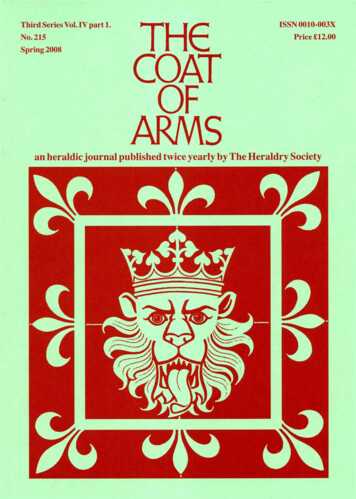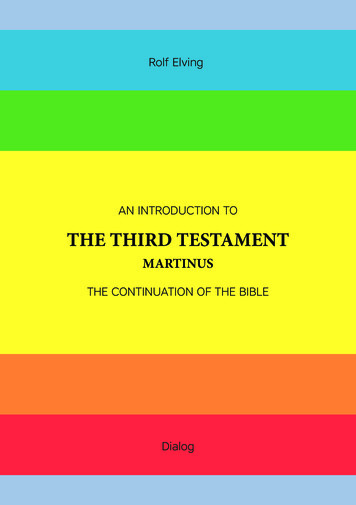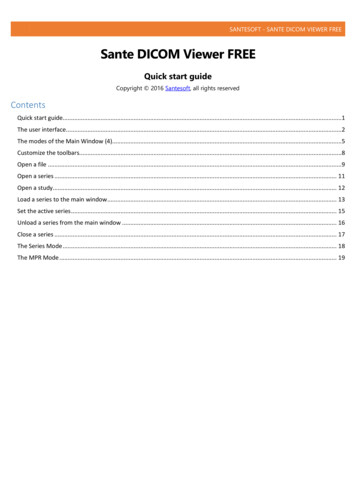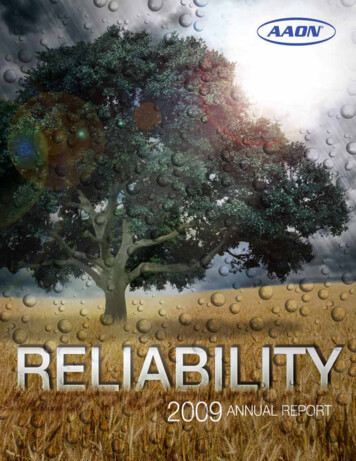
Transcription
Third Series Vol. IV part 1.No. 215Spring 2008THECOATOFARMSISSN 0010-003XPrice 12.00an heraldic journal published twice yearly by The Heraldry Society
THE COAT OF ARMSThe journal of the Heraldry SocietyThird seriesVolume IV2008Part 1Number 215 in the original series started in 1952
The Coat of Arms is published twice a year by The Heraldry Society,whose registered office is 53 High Street, Burnham, Slough SL1 7JX.The Society was registered in England in 1956 as registered charity no.241456.Founding Editor†John Brooke-Little, C.V.O., M.A., F.H.S.Honorary EditorsC. E. A. Cheesman, M.A., PH.D., Rouge Dragon PursuivantM. P. D. O’Donoghue, M.A., Bluemantle PursuivantEditorial CommitteeAdrian Ailes, B.A., F.S.A., F.H.S.Jackson W. Armstrong, B.A.Andrew Hanham, B.A., PH.D.Advertizing ManagerJohn Tunesi of Liongam
PLATE 2CA Ms William Jenyns' Ordinary, fo 29v.See page 23.
PLATE 3CA Ms William Jenyns' Ordinary, fo 19r.See page 24.
THE MEDIEVAL ORIGINSOF THE BRITISH SYSTEM OF CADENCYPaul A. FoxThis paper seeks to show how the cadency marks described by writers on heraldryand used today in England and Wales, Scotland and Ireland came to be established,concentrating upon the evidence provided by a hitherto largely overlooked medievalmanuscript source. It also notes the influence of published works on the evolution ofcadency practices in the sixteenth century.1Heraldry began to develop rapidly during the twelfth century at much the sametime that the fully visored helmet was popularized. With the face concealed it becameessential to distinguish knights on the field of battle in some other way, and in thatcontext the ability to distinguish a father from his sons would have been extremelyimportant. It is a safe assumption that the differencing of the arms of sons would havebeen required even when heraldry was in its infancy, but our sources of informationfor this remote period of time are limited.The number of ways that arms might be changed to distinguish between twomembers of a family is virtually limitless, but in practice the most popular earlymethods were colour changes; powdering the field with other charges (‘geratting’);the addition of a bend or a border; and the addition of other charges which might besingle or multiple.Of these latter charges, the one most consistently used from the earliest periodis the label, thought to be a depiction of a ribbon with a variable number of pendantstrips which was worn around the neck, and possibly sometimes around the helm.One can imagine that the younger knights and squires at tournaments would haveworn such fancy ribbons, perhaps to impress the ladies, and it is possible that suchcollars were sometimes bestowed as tokens. This association with youth wouldexplain why the label, not at its inception the mark of a son, would have yet beenconsidered a very suitable distinction for one.The earliest verifiable example of the use of the label dates from around 1215and is certainly not a father-son difference. These are the arms of Saher de Quincy,Earl of Winchester: Or a fess gules with a label azure.2 The arms of Quincy were infact Gules seven mascles or, arms which appear on the contemporary seal of Saher’sfirst cousin Robert Fitzwalter. The two men were prime movers in the revolt against1J. R. Planché studied the history of cadency marks in The Pursuivant of Arms (third edn.,London 1873), pp. 176-89. The next useful survey of the subject appears in A. C. Fox-Davies,A Complete Guide to Heraldry (first edn. London 1909; rev. J. P. Brooke-Little, London 1969),chapter 31. There is a less detailed but clear study in Boutell’s Heraldry (rev. J. P. BrookeLittle, London 1973), chapter 10.2 Henry Laing, Descriptive Catalogue of impressions from ancient Scottish Seals (Edinburgh1850), p. 128 and plate xi: the date given here is incorrect. The seal carries the title Earl ofWinchester, which was bestowed on de Quincy in 1210.The Coat of Arms 3rd ser. 4 (2008), no. 215, pp. 21-8.21
THE COAT OF ARMSKing John, and both adopted the fess gules at this time. Fitzwalter took his ancestralClare arms, Or three chevrons gules, and changed the central chevron to a fess. Ifthe seals of de Quincy and Fitzwalter are placed side by side they appear to be ridingtowards each other, and each man has placed the other’s arms in the same position onthe seal. This combined with the adoption of the fess gules points to some powerfuljoint symbolism, most probably the two cousins had sworn blood brotherhood, forwhich it is hard to imagine a more appropriate heraldic device than the fess gules.Although the label azure may have also borne some connotation which is now lostto us, its addition was probably necessary because Or a fess gules was already in useby another knight.The use of the label by de Quincy may have helped to popularize it. It is unlikelyto be coincidental that the earliest known Scottish example of the label being used foran eldest son occurs in the family of Seton, who were feudal tenants of de Quincy.Saher de Seton’s Christian name emphasizes that connection. He and his eldest sonAlexander sealed one of the Holyrood Charters around 1260, the father with threecrescents, the son with three crescents and a label of three points.3In England the earliest surviving roll of arms (excepting the Matthew Parisshields), Glover’s Roll, dates from the 1250s, and contains thirteen examples ofthe use of the label. Of these, only three are eldest sons within the lifetimes oftheir fathers. The most important of these is the king’s own son and heir, the PrinceEdward. A fourth knight, Thomas de Multon, occupies an unclear position becausealthough he was a son and heir his father had already died, in 1246. Six of the knightswere definitely not eldest sons, of whom Edmund de Lacy, Earl of Lincoln, was usingthe label to distinguish his arms from the family of Eure.4It is a fair supposition that the other five charges later added to arms to denoteyounger sons: the crescent, the mullet, the annulet, the fleur-de-lys, and the martlet,also came into use as cadency marks during the thirteenth century. For only one ofthese, however, has it been possible to find evidence from this early period, and thatis the fleur-de-lys. In 1260 Humphrey de Bohun, then an eldest son, differenced withone.5 The three-part structure of the lily has long been regarded as an allusion to theblessed Trinity, but perhaps more pertinently the three lobes were said to representwisdom, faith and prowess.6 There are several other early examples of its use, from1292, and in the Parliamentary Roll of c. 1312, when it appears on the arms of Gilesde Brewes.7By the early fourteenth century examples of the use of modern cadency marksbecome very numerous. There is an excellent and much neglected source for cadency3Laing, op. cit. no. 736 and plate 10. See also Sir James Balfour Paul, The Scots Peerage, vol.viii (Edinburgh 1911), p. 562.4 For Glover’s Roll, ed. H. S. London, see Rolls of arms of Henry III (Aspilogia 2: London1967), pp. 115-166. Of the final three knights not enough genealogy is known to indicate their5 BM Seals no. 7530.status.6 Guy Cadogan Rothery, Concise Encyclopedia of Heraldry (London 1985), pp. 166f.7 For the 1292 example, Laing, op. cit. p. 58 no. 307; and for the Parliamentary Roll see SirNicholas Harris Nicolas, A Roll of Arms of the Reign of Edward the Second (London 1829),p. 30.22
MEDIEVAL ORIGINS OF THE CADENCY SYSTEMin this period: William Jenyns’ Ordinary (henceforth WJO; Plate 2).8 This roll wouldseem to date from the reign of Edward III, but the only surviving medieval copy wascreated in the time of Richard II with some small additions, and this copy is preservedin the College of Arms. An examination of this manuscript shows that, uniquely, itgives cadency marks to all the sons of some of the leading families, while at the sametime stating whether they were the eldest, second or third son, and so on. With the aidof this manuscript it is thus possible to address the development of the other cadencymarks, and I will do so in the order with which we have now become familiar.The crescent, now the mark of the second son, was in the medieval periodquite a popular choice for the eldest son. In WJO there are seventy-nine examplesof eldest sons using the label, fifteen using crescents, fifteen using mullets and nineusing annulets. From the same source it appears that the crescent was used most indescending order of frequency by the first, second and third sons.9 Representing thewaxing or increasing moon, the crescent has been associated from ancient times withfertility and prosperity. It is said that the crescent moon was much used in Byzantiumand thus acquired by the crusaders, in which context it is not surprising to find it onthe great seal of Richard I.10The mullet, now the mark of the third son, occupies in WJO joint second placein frequency with the crescent as the mark of an eldest son; it was also used withapparent equal preference by second and third sons.11 Probably the best known earlyexample of the use of the mullet as a form of feudal differencing is the family of deVere, who used the mullet to distinguish themselves from de Mandeville. The mulletis often confused with a spur rowel, which has the same shape, but which naturallyhas a hole in its centre.12 A star was used on coinage from the reigns of the Conquerorthrough to Henry I, evidently as a religious emblem. Anciently the morning star wasassociated with fertility. To be fruitful and to multiply were the most important dutiesof an heir.The martlet, now the mark of the fourth son, was probably never used inthe Middle Ages by the eldest son: writers on heraldry ascribed to it a particularsymbolism which made it unsuitable for this use. The first British treatise on heraldry,the Tractatus de Armis of c. 1394, includes the following passage:13The martlet borne in arms signifies that the bearer has acquired nobility either by hisbravery and prowess or by his intelligence, and that he has but little inherited wealth.The heraldic martlett has no feet, like something without foundation. Those who bearthe bird dwell in the courts of lords or kings and live on the bounty of those lords.8CEMRA, pp. 69-71. A more detailed account of this manuscript is in preparation.Examples from WJO of the use of the crescent by the second son include Audley of Heleigh,Mowbray, Percy and Strange of Knockyn; by the third son, Beauchamp and Neville.10 Rothery, op. cit. pp. 92f.11 Examples from WJO of use by the second son are Fauconberge and Neville; by the third son,Percy and Holland.12 The spur rowel is generally referred to in England as a pierced mullet.13 The text that follows is an adaptation of the translation by Evan John Jones from the Welshversion of the Tractatus, the Llyfr Arfau: E. J. Jones, Medieval Heraldry (Cardiff 1943), p. 45(cf. p. 122 for the Latin version).923
THE COAT OF ARMSAlexander Neville, Archbishop of York 1374-88, is a good example of a youngerson who rose to wealth and power and adopted the martlet as his mark of cadency.The Great Cloister of Canterbury Cathedral, dating from the reign of Henry IV, hasexamples of the martlet being used by younger sons of the families of Colepeperand Leventhorpe.14 The most senior son in WJO to have borne the martlet was SirThomas Neville, Lord Furnival (1377-1407), who was second son of the first Earl ofWestmoreland.The annulet, now considered the mark of the fifth son, was thought to be anemblem of wealth and fidelity; it was also connected with the tournament. Thetournament ring was hung from a cross-beam and the knight had to carry it off onhis lance while riding at full tilt. The importance of the ring as a symbolic object isevidenced by the ancient legends which were the inspiration of Wagner’s Ring Cycleand Tolkien’s Lord of the Rings. In WJO there are examples of its use from the secondthrough to the sixth son, and as a popular choice for cadency it ranked above themartlet and the fleur de lis.15One family which has long been cited as the best medieval example of themodern usage of cadency is that of Beauchamp Earl of Warwick (Plate 3). Dugdalerecorded the use of all six marks by the sons of Sir Thomas (Beauchamp), third Earlof Warwick, K.G., who died in 1369, from the windows in the chantry chapel of thefamily in the church of St Mary’s, Warwick. These windows were smashed by thePuritans not long after they were copied by Wenceslaus Hollar. It must be emphasizedthat apart from the use of the label by the eldest son, none of the cadency marksstands for the same son that it would indicate in modern usage.16There are rare examples of individuals changing their cadency marks laterin life, suggesting perhaps that the distinction had been chosen by the head of thefamily and was not to their liking. All the indications are that the heralds of the dayallowed families to devise their own systems of cadency provided that each markwas unique.Medieval literature confirms that in the fourteenth and fifteenth centuries therewas still no uniform system. The Tractatus de Armis, for instance, states that ‘theeldest son during his father’s lifetime bears his father’s arms with a cross or someother little difference’ but on the same page informs us that the eldest son bears a14The eldest son of Sir John Leventhorpe (who himself had a crescent for difference) bore thelabel, the second to fourth sons took the annulet, the martlet and the rose, and the fifth son usedthe mullet. Sir John Colepeper of Oxenhoath in Kent himself had an annulet for difference:his eldest son bore a crescent during his father’s lifetime. The second and third sons used themullet and the martlet.15 WJO has 149 examples of the use of the label, 43 of the use of the mullet, 32 of the crescent,24 of the annulet, 15 of the fleur-de-lys and 13 of the martlet. Here we find it used by thesecond son in the family of Beauchamp, by third and fourth sons in different generations of theNevilles of Raby, and by the sixth son of Henry, Lord Percy (d. 1353).16 Instead we have: second son annulet, third son crescent, fourth son fleur-de-lys, fifth sonmullet and sixth son martlet.24
MEDIEVAL ORIGINS OF THE CADENCY SYSTEMlabel of three or four points during his father’s lifetime.17 These two statements reflectcontemporary heraldic indecision. The work goes on to say that the second son bearsa label of three points, the third son a label of five, and so on, and this decidedly isboth contradictory and at variance with heraldic practice today.What we in fact have here is the first recorded attempt to establish a formalsystem of cadency, one which was never adopted. The Tractatus was not a guidebook on heraldry, but rather a philosophical discourse which described heraldry inaccordance with the Aristotelian principles of logic, classification and natural history,the basis of university education at the time. It is not surprising therefore that thebook became very popular to the extent of being widely plagiarized. Nicholas Upton,writing his De Studio Militari around 1440, copied the work and inserted some of hisown ideas. What Upton said was in turn copied verbatim by Dame Julian Berners intothe Book of St Albans:18The first son shall bear the arms of his father with some little difference as here[indicating a mullet shown in illustration] to whom specially is given a moonincreasing, and this difference may be a little mullet. The second brother shall bear thearms with a label of three points, to signify that he is the third to bear those arms. Thethird brother shall bear a label of four points, and if there are more brothers you shallincrease the number of points.The sons of the brothers will bear the same labels. For instance the second son’s eldestson will add a little difference [marginal illustration of a cinquefoil] and the second sonwill bear his father’s arms surrounded by a border. The third son will have his father’sarms with a border of a different colour.One hundred and fifty years after Upton, the idea of differencing the sons of a cadetwith a border was taken up by the Lord Lyon in Scotland when in 1590 by act of theScottish Parliament all arms had to be registered.19No clear distinction can be made between the sorts of cadency markings whichwere popular in the British Isles during the medieval period and those employed inother parts of western Europe. The fifteenth-century Golden Fleece armorial givesvery similar examples in the two sections which are substantial enough to includecadets, those of Normandy and Flanders.2017Jones op. cit. p. 71, and the same in the Latin versions pp. 134 and 184. It is in the contextof the Scrope-Grosvenor case that John Trevor, Bishop of St Asaph, wrote this first treatiseon heraldry for Queen Anne, wife of Richard II, as convincingly argued by Evan Jones op.cit. Criticism of the work as an antiquarian source was voiced by Oswald Barron, quoted andseconded by Anthony Wagner in his introduction to Jones’s Medieval Heraldry pp. xii-xv.18 Dame Julian Berners, Book of St Albans (St Albans 1486, reprinted by Wynkyn de Worde,Westminster 1496; ed. D. B. Appleton, 2003), pp. 58f.19 See J. H. Stevenson, Heraldry in Scotland (Glasgow 1914), vol. 2, chap. 10, for a discussionof Scots cadency practice; see also Sir Thomas Innes of Learney, Scots Heraldry (rev. edn.,Edinburgh 1956), chap. 8.20 Michel Pastoureau and Michel Popoff (edd.), Grand armorial équestre de la Toison d’or(two vols., Saint-Jorioz 2001), an edition of Paris, Bibliothèque de l’Arsenal Ms 4790.Admittedly Normandy was at that time under English suzerainty, but it was largely populatedby Frenchmen. The escutcheon of pretence appears to have been quite a popular cadency markin both of these territories, more so than in England.25
THE COAT OF ARMSFigure 1: CA Ms William Jenyns’Ordinary, fo 1r (detail), showing arms ofvarius members of the Holland familydifferenced with small charges and dated1562.The next development which took place was a very obvious and logicalrefinement of established practice. Following the creation of the College of Arms,Garter King of Arms is thought to have taken six commonly used cadency marksand attached each mark to a particular son. Tradition names Garter Writhe as theoriginator, but there were two Garter Writhes, father and son. The former reignedfrom the time of the College’s inception, but there is evidence that the distinctioncould not have been made so early.During the sixteenth century WJO came into the possession of a Lincolnshirefamily by the name of Holland, and in 1562 Thomas Holland had his own familyinserted on one of the blank pages (Figure 1). His younger brother is given a crescent,but the third brother bears a fleur-de-lys, and the fourth an annulet, whilst of his twograndsons the elder has a crescent and the younger a fleur-de-lys. The year 1562 hasa particular significance because it saw the publication of Gerard Legh’s Accedensof Armory, the book which first laid down the complete set of nine cadency markswith which we are now familiar (Figure 2). The cadency section is introduced withthe following words: ‘I proceed to tell you of nine sundry differences of brethren,whereof I warn you to give good heed.’21Leigh was a lawyer, not a herald, but it is scarcely conceivable that he would nothave been in communication with the heralds of the day on a matter of such evidentimportance. It seems that there was official sanction for the first six marks, butthat Leigh perhaps exceeded his authority in devising three additional ones.22 John21Gerard Legh, Accedens of Armory (London 1562), fo 183; fo. 107 in the edn. of 1568.Seventh son: rose; eighth son: cross moline; ninth son: double quatrefoil. The Scots lateradded a tenth mark, the anchor, between the cross and the quatrefoil.2226
MEDIEVAL ORIGINS OF THE CADENCY SYSTEMFigure 2: Gerard Legh, The Accedens ofArmory (repr. London 1568), fo 108r. Part ofthe section on marks of cadency.Bossewell in his book The Workes of Armorie published in 1572 stated that ‘there aresix sundry differences of arms for brethren. If there be more than six the assignmentof further differences appertains to kings of arms.’23 John Guillim, appointed RougeCroix Pursuivant in1613, informs us in his Display of Heraldrie published in 1611,that it was Gerard Legh who added the other three.24Clearly the six marks were instituted some time before 1562, but the question iswhen? Such regulation would have become necessary when the heralds began theirregular visitations in the 1530s. It is a reasonable assumption that Garter Writhe (laterWriothesley) junior, who succeeded his father in 1505 and died in 1534, oversawtheir establishment. Ultimately Legh’s scheme became the accepted orthodoxy,despite some opposition, for example from William Wyrley (appointed Rouge CroixPursuivant in 1604) who in his True Use of Armorie of 1592 wrote that he speaks out‘against these ordinary differences, knowing them to be but new inventions.’25The Holland family shields added to WJO demonstrate that the authority of thevisitations had not by 1562 brought the new system into universal use; knowledgeabout the scheme does not seem to have been widely disseminated until the laterElizabethan publications on heraldry.The unsatisfactory idea of placing cadency mark on cadency mark had alreadybeen devised by 1611, when Guillim declared himself not to be in favour of it. Wehave an example of its use from that very period in the funeral certificate of Sir23John Bossewell, The Workes of Armorie (London 1572), fo 10v.John Guillim, A Display of Heraldrie (London 1611), pp. 450-6.25 William Wyrley, The True Use of Armorie (London 1592), pp. 13f.2427
THE COAT OF ARMSWilliam Cockayne who died in 1626.26 As a third-generation second son he hadthree crescents of different colours, all superimposed. This became known as theEnglish system of cadency, but it has never had unequivocal official support. WilliamCamden, who was Clarenceux in the time of Guillim, was of the opinion that for theyounger sons of younger sons the assigning of differences should be at the discretionof the King of Arms of the province.27 The same view was held by Sir WilliamDugdale, who was Garter from 1677 to 1686; instructions to this effect given by SirHenry St George, Clarenceux, to the heralds during their visitations survive from1681.28 Despite holding these views, Dugdale’s own book on cadency included aplate illustrating the use of mark on mark.29In Scotland, where all cadets are still required to register their arms, the robustbut flexible system which found favour with Camden and Dugdale is still maintained.The end of the visitations in England and Wales has resulted in some erosion ofthe ability of the College of Arms to enforce the differencing of arms. The decisionto employ the so-called English system in any given case is now entirely at thediscretion of the kings of arms.3026Cited in Fox-Davies, A Complete Guide to Heraldry (1925 edn.), p. 344.Sir William Dugdale, The Antient Usage in bearing such Ensigns of Honour As arecommonly call’d Arms (Oxford 1682), p. 25.28 A. R. Wagner, Heralds and Heraldry in the Middle Ages (Oxford 1939), Appendix E, p.148.29 Dugdale, op. cit., plate opposite p. 36.30 This article is based on the text of a lecture delivered to the Heraldry Society on 21November 2007.2728
gives cadency marks to all the sons of some of the leading families, while at the same time stating whether they were the eldest, second or third son, and so on. With the aid of this manuscript it is thus possible to address the development of the other cadency marks, and I will do so in the order with which we have now become familiar.











